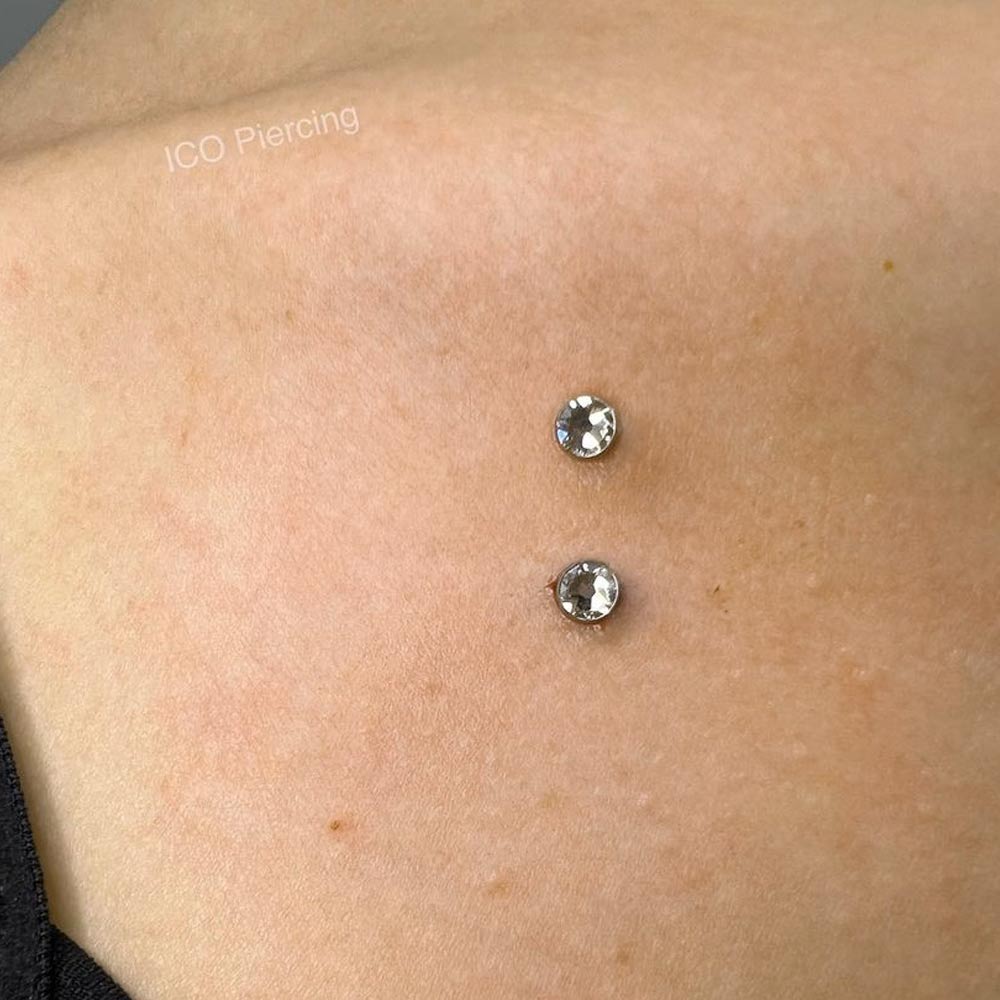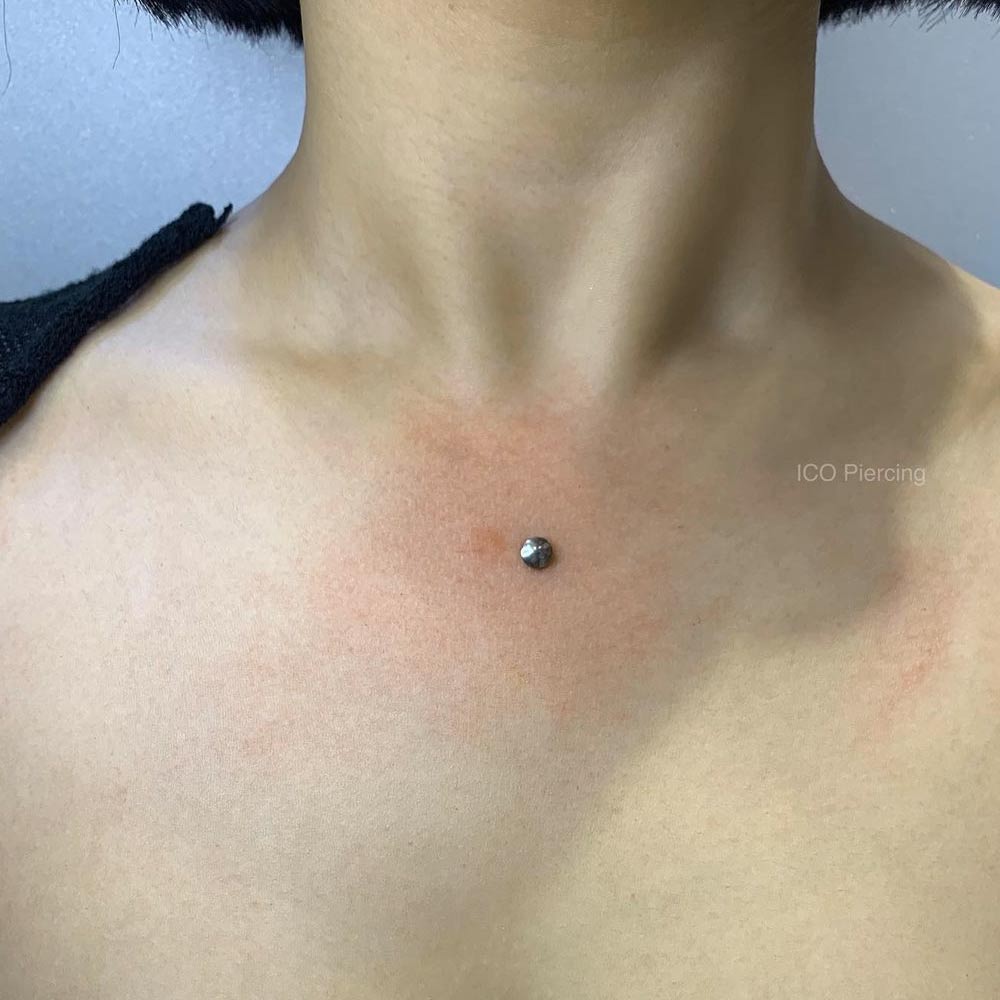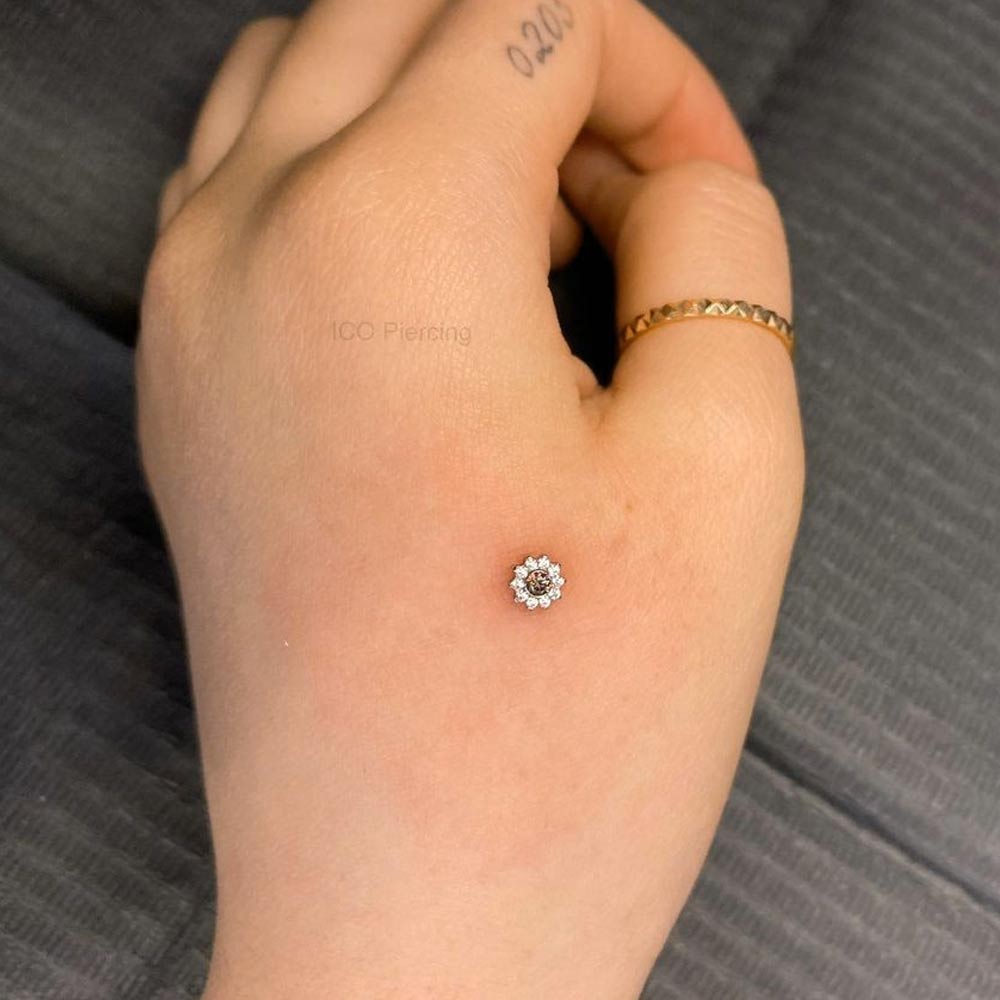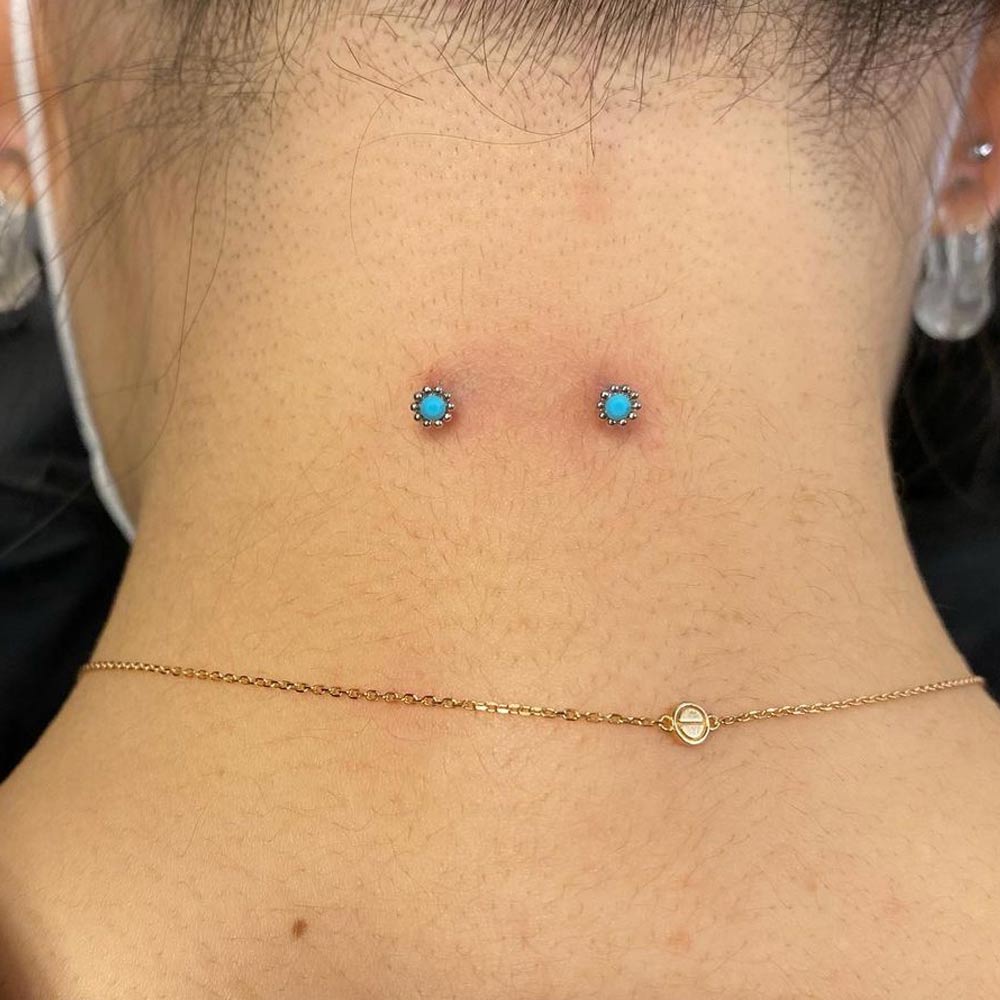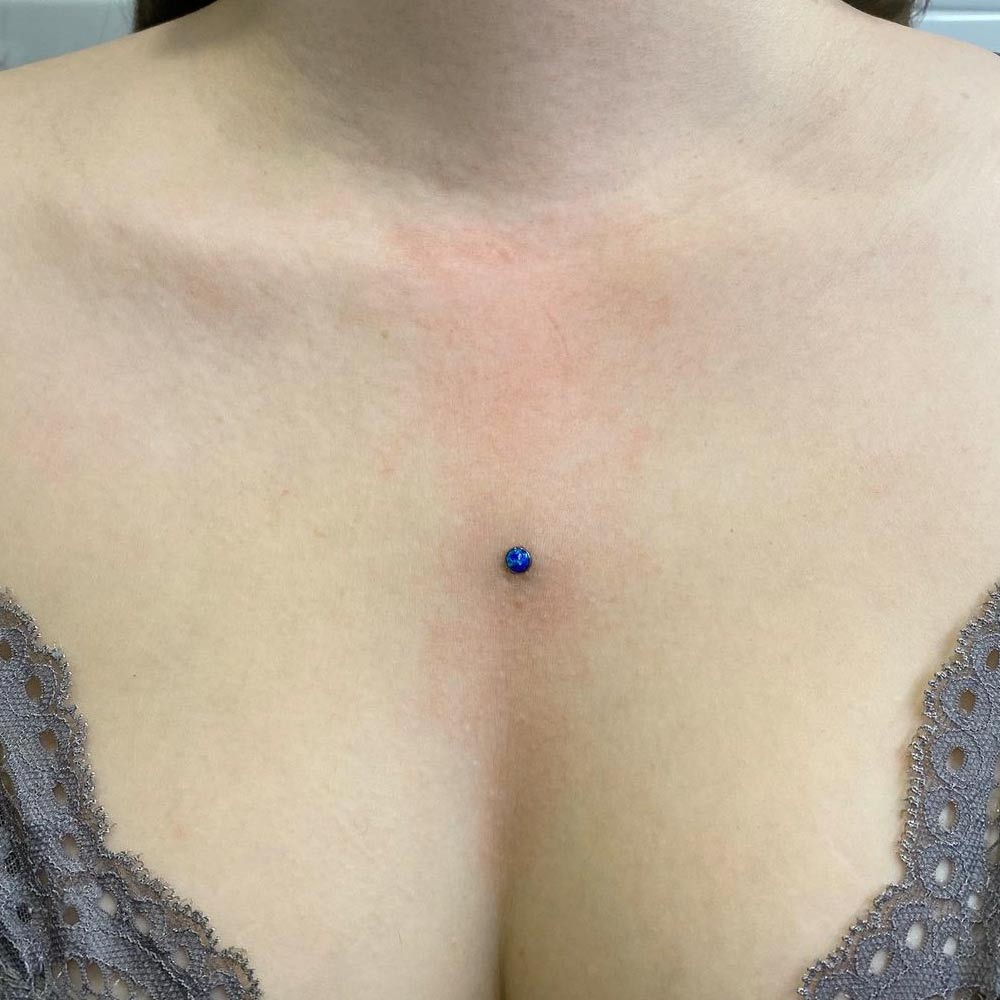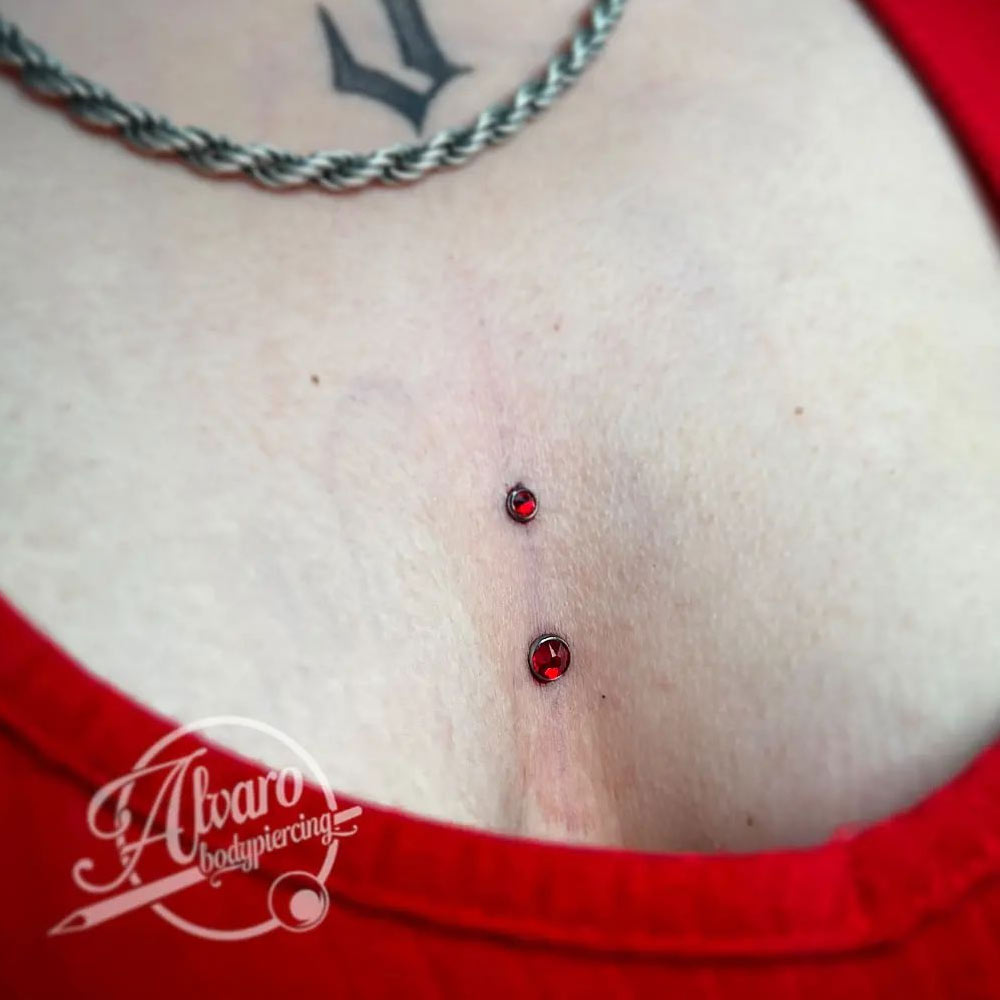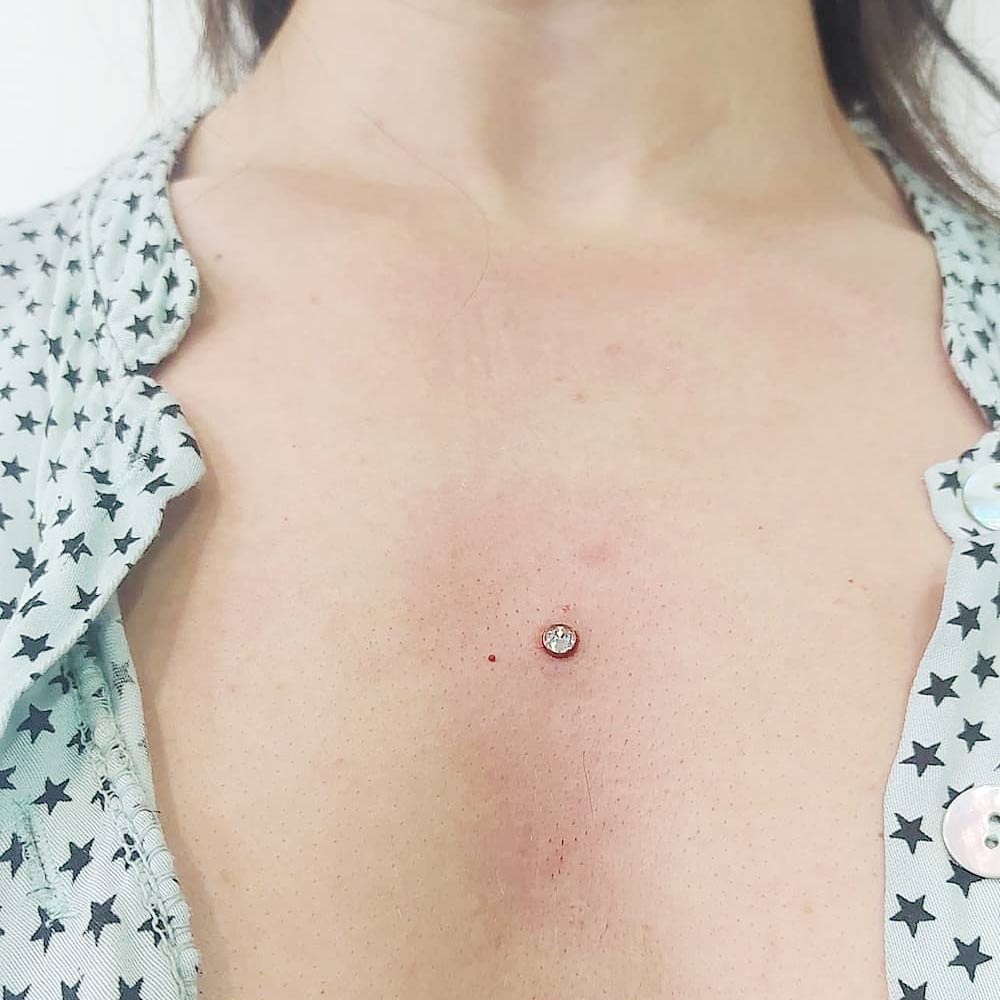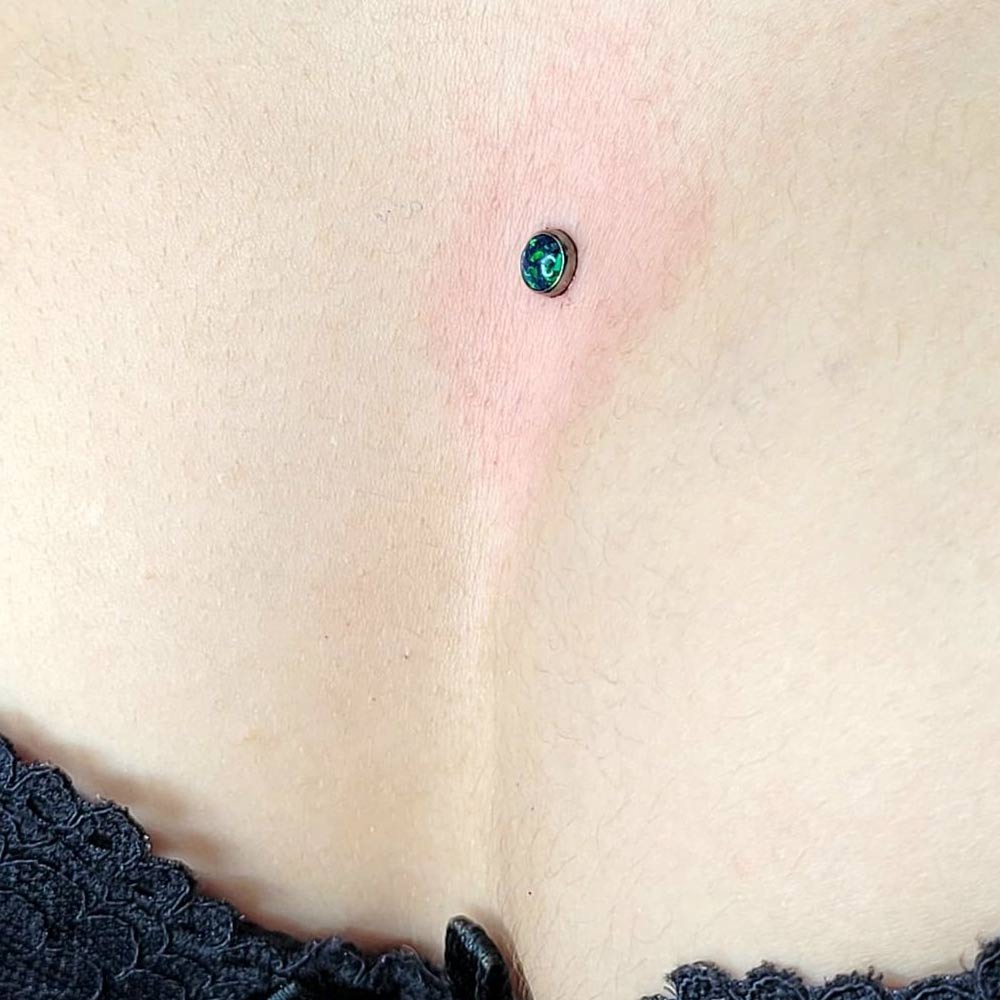One of the most outstanding features of dermal piercing is the fact that you can locate it basically anywhere on your body. There are no limits to face so that you can get as creative as you wish. Yet, there is a list of risks to keep in mind. Besides, compared to the regular piercing, the dermal one is a bit more complicated and requires a fair share of theoretical knowledge to finalize the decision about getting it done. Care to learn more on the matter? Read on!
What is a Dermal Piercing?
Credit photo: Instagram.com/icopiercingFirst things first - what is a dermal piercing? You may be well aware of the general definition of body piercing, but dermal piercing is something utterly different. The fact is that all piercings dermals are the only ones that have no exit holes. This makes the option so versatile and adaptable that you can place it literary anywhere on the body and create unique patterns to stand out from the crowd. Yet, you should realize that only a trained professional will be able to succeed with the process successfully since it requires precise incisions in your skin.
No bar or ring can hold the piercing in place. Whether it is a face dermal piercing or any other type that you aim at, these should be specific jewelry with securing anchors used to keep the piercing in place. On the bright side, you can experiment with the heads of your dermals endlessly since the variety of those grows by the day.
Even if the primary infection is prevented and the procedure is performed correctly, secondary infection may occur.
To prevent secondary infection:
- use special piercing aftercare spray;
- avoid touching it with your hands;
- sleep well;
- carefully monitor your physical condition and avoid stress.
If there are any signs of inflammation or complications, it is best to visit the salon where you've got your dermal piercing and consult your pierer.
Dermal Piercing Types
Credit photo: Instagram.com/icopiercingNow, when you know what such a piercing stands for, you should be aware of the most popular types and locations that are on the edge of popularity at the moment.
- Face dermal piercing – a classy dermal face piercing can be located on any part of your face, where a surface option is physically impossible. Think your forehead, around the eyes area, or chin, as most requested alterations, but there are no limits here.
- Cheek dermals – dermal cheek piercing is a great variant when regular dimple piercings are too mundane for you. You can enhance the cheekbones with dermal studs and insert more than one piercing to emphasize your personality.
- Chest dermal piercing – dermal chest piercing is yet another popular placement to put a dermals in. you can pick any location that suits your taste. Still, clavicle dermals are the hottest trend of the season.
- Cleavage dermal piercing – if you are looking for a sexually-charged type of dermal piercing, you may as well have found it. The truth is that the sternum piercing looks utterly intimate and elegant. Besides, not everyone would have a chance to observe from a close-up distance, making it twice as exceptional.
- Back dermals – has it occurred to you that the cheek dimples aren’t the only cute dimples in the area? A lower back dermal piercing proves that back dimples are as attractive and more unique than the classy ones.
Dermals or Surface Piercings?
Credit photo: Instagram.com/icopiercing Credit photo: Instagram.com/icopiercingSome people still mistakenly assume that dermal piercing and surface piercing represent the same notion. However, you should keep in mind that, unlike a surface piercing, a dermal can be located anywhere on your body since it requires no exit point. While a surface piercing is deemed to penetrate your skin with a two-way opening, a derma is inserted in the top layer of the skin.
On a slightly darker side, you should remember that you can’t remove a dermal on your own after it heals. A surface piercing can be easily taken out on your own should you get bored of it or it starts to migrate. Yet, surface piercings tend to leave more noticeable scars when compared to dermals.
Pain level
Of course, getting your skin pierced will hurt. After all, the piercer will puncture it and insert jewelry. But there are many things that factor in the pain level of piercing, namely:-
- The location. As a rule of thumb, the pain levels change from the highest in the cartilage area to the lowest in the soft tissues.
- The piercing type. Dermal piercings are among the least painful ones.
- Your pain threshold. How well you tolerate pain affects greatly how painful getting a dermal piercing is going to be for you.
- Skills and expertise of your piercer. Though, they should specialize in this exact piercing type, as a dermal piercing requires a little different approach.
Dermal Piercing Aftercare
Credit photo: Instagram.com/icopiercingAll types of piercings require a particular aftercare routine to ensure that the piercing heals properly and you get the desired outcome with as little effort involved as possible.
Cleaning rules
It is not enough to deal with the process successfully. You need to ensure that you are keeping your piercing clean and well-treated so that it heals well. Keep these points in mind to ensure a speedy healing process and the absence of infections.
- Cover your piercing with a bandage for a few days after the procedure.
- Don’t touch the area with unwashed hands.
- Clean the area twice a day, the least.
- Wipe away the crust that you notice in-between the cleanings.
- Cover the area when you get in the shower.
- Don’t wear tight clothes over the piercing.
- Don’t engage in sports that may put a lot of pressure over the pierced area.
- Don’t remove the jewelry until it is fully healed.
Healing time
The healing time of the dermal piercing may last anywhere between 4 weeks and 3 months. This period may be extended or reduced, depending on how thoroughly you take care of the piercing after getting it done. Right after the procedure, your skin will be swollen. A new piercing may ooze blood or other fluid. There may also be crusts around the piercing. In two weeks, you should notice an improvement: oozing or crusting should not bother you much. In case the symptoms continue while the fluid changes color to green or yellow, emitting a specific odor, and the skin around the piercing is hot, it is most likely that there is an infection.
Dermal Piercing Cost
How much is a dermal piercing depends on many factors. On average, a dermal piercing price varies from $70 to $100. Depending on the studio where you are going to be pierced, you may need to pay extra $10-$20 for piercing jewelry. And, of course, do not forget to tip your artist around 20% of the total cost. There may also be other expenses. For example, you may need to pay for saline solution and other aftercare.
Risks of Getting Dermal Piercing
Credit photo: Instagram.com/alvarobodypiercingObviously, a dermal piercing entails certain risks. So, it pays to know about them before getting your skin punctured. The most common issues you may have to deal with include:
- You can introduce the infection to the wound. And not always it is you. When the piercer does not make sure everything is sterile and clean, the piercing may start to harbor bacteria. The same happens when you do not follow a proper aftercare routine.
- The piercing may migrate. It is important to implant the anchor of the dermal deep under the skin. Otherwise, it may change its location.
- Your body may reject the piercing. There are many reasons why your body may be rejecting a dermal piercing. When the anchor is displaced, your skin may try to push it out. But sometimes instead of incapsulating it, your body starts to treat the jewelry as a foreign object, so it is not welcome.
- The tissues can get damaged. While it is necessary to insert the anchor deep enough, it is also important not to overdo it, as it can cause damage to your nerves and blood vessels.
- Overgranulation may occur in the pierced spot. If you wear tight jewelry or fabric over it, apply makeup to the perforated skin, do not clean it properly and play with or touch the jewelry, it may cause overgranulation.
- You can end up with a scar. Dermal piercing scars are quite a common case. If you have retired it, your body has rejected the jewelry or you have had dermal piercing removal, it may leave a scar on the piercing site.
How to Change the Jewelry Top
Credit photo: Instagram.com/alvarobodypiercingAs soon as the healing of your dermal piercing is over, you may want to switch up the top of the jewelry. But this is not the same as with the regular piecing. So, it is better to entrust the task to a professional, i.e. your piercer. Yet, in case you feel like doing it on your own, take care to stick to the following:
- Ensure your hands are clean. Use a soap with antibacterial properties to wash them.
- Sanitize the piercing spot using a saline or sea salt solution.
- Dry the skin by patting it with a paper towel.
- If the piercer screwed on the top clockwise, you should twist it in the opposite direction. It should go pretty smoothly. If not, then ask the piercer for help. They have special forceps that allow them to do it without causing harm to the skin.
- Attach a new top and screw it on. Now you should twist clockwise.
- Sanitize the pierced skin again and dry it with a clean towel.
How to Retire the Piercing
Credit photo: Instagram.com/alvarobodypiercingOnly your piercer knows exactly how to remove a dermal piercing properly. You should never attempt to do it yourself. So, if you have decided to retire it, just book an appointment with the salon. Wondering what you should expect from the procedure? Here is how to remove dermal piercing:
- The piercing spot will be sanitized with a sea salt or saline solution.
- The top of the jewelry will be removed.
- So that the anchor dislodges, the piercer will give the skin around the piercing a light massage.
- With a scalpel, they will dissect the skin so that the anchor could fit it.
- The scar tissue surrounding the anchor will be cut off using a scalpel too.
- The anchor will be removed from the hole with the help of the forceps.
- The wound will be covered with a bandage or suture.
Basically, this procedure can be performed by any professional specializing in surgery. But it is still advisable to see your piercer for a consultation. You may get useful recommendations as well as some points for and against dermal piercing removal.
FAQ
How long should you cover a dermal piercing?
It is advised to keep your dermal piercing covered for around a fortnight to help it settle in and start to heal. However, you should leave it exposed to the air, too, since it is a natural healing process requirement. Don’t soak the piercing too long in the shower. Keep it hidden under your hand if that is an option.
Should I massage my dermal piercing?
If you want to have the piercing removed, then you should massage it to dislodge it. However, in case that is not the intention, you shouldn’t be touching the area more than necessary, let alone massaging it.
What is the most common dermal size?
Usually, dermal piercings are small and range from 18g to 16g. Yet, there are exceptions, and some people choose 12g and 14g instead.
Was this article helpful?




